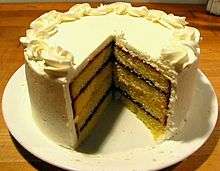Charlotte (cake)
A charlotte is a type of dessert or trifle that can be served hot or cold. It is also referred to as an "icebox cake". Bread, sponge cake or biscuits/cookies are used to line a mold, which is then filled with a fruit puree or custard. It can also be made using layers of breadcrumbs.
 Chocolate and pear charlotte, with the typical ladyfinger biscuits clearly seen. | |
| Alternative names | Ice-box cake |
|---|---|
| Course | Dessert |
| Place of origin | France |
| Serving temperature | Hot or cold |
| Main ingredients | Bread, sponge cake or biscuits; fruit puree or custard |
| Variations | Charlotte russe |
Classically, stale bread dipped in butter was used as the lining, but sponge cake or ladyfingers may be used today. The filling may be covered with a thin layer of similarly flavoured gelatin.
Types
Due to the simple preparation of charlottes, many different varieties have developed. Most charlottes are served cool, so they are more common in warmer seasons. Fruit charlottes usually combine a fruit purée or preserve with a custard filling or whipped cream. Some flavors include strawberry, raspberry, apple, pear, and banana.
Other types do not include fruits, but use a custard or Bavarian cream. Chocolate charlotte uses a mousse filling within the layers. A citrus curd is a more contemporary choice.
Russian Charlotte or Charlotte russe is a dessert invented by the French chef Marie-Antoine Carême (1784–1833), who named it in honor of his former employer George IV's only child, Princess Charlotte,[1] and his current, Russian employer Czar Alexander I (russe being the French word for "Russian"). It is a cold dessert of Bavarian cream set in a mold lined with ladyfingers.[2]
An alternative to this is a Charlotte Royale, which has the same filling as a Charlotte russe, but replaces the ladyfinger lining with Swiss roll.[3]
Charlotte russe was also a dessert or on-the-go treat sold in candy stores and luncheonettes throughout the five boroughs of New York, popular during the 1930s, 1940s, and 1950s. It consisted of a paper cup filled with yellow cake and whipped cream topped with half a maraschino cherry. The bottom of the cup is pushed up to eat.[4]
A summer alternative is Charlotte cake with strawberry and mango having the basis of Savoiardi biscuits (ladyfingers) soaked in orange liqueur.[5]
Etymology
There is a lot of doubt surrounding the origins of the name charlotte. Despite the fact that charlottes are served across Europe, one etymology suggests it is a corruption of the Old English word charlyt meaning "a dish of custard". In another, meat dishes that were known as charlets were popular in the 15th century. Other historians say that this sweet dish took its name from Queen Charlotte (1744–1818), wife of George III of the United Kingdom.[6][7] It is possible that the dessert takes its name from Alexander I's sister-in-law, Charlotte of Prussia.
See also
| Look up charlotte in Wiktionary, the free dictionary. |
| Look up charlotte russe in Wiktionary, the free dictionary. |
References
- "January 07 Princess Charlotte Augusta of Wales' Birthday". Medadvocates.org. Retrieved 2013-11-05.
- "charlotte russe". The American Heritage Dictionary of the English Language, Fourth Edition. Boston: Houghton Mifflin Company, 2004. Accessed via Dictionary.com, February 27, 2010.
- "Charlotte Royale". Food- dictionary.com. Archived from the original on 2010-07-29.
- See:
- Leah Koenig (Feb. 6, 2012) Capital: Lost foods of New York City: Charlotte Russe (with recipe)
- Charlotte Goldblatt (April 6, 2013) Daily Food & Wine: Retro Brooklyn; searching for a Charlotte russe (recollection & recipe)
- New York style Charlotte russe is mentioned in the book A Tree Grows in Brooklyn by Betty Smith (1943), chapters 16 and 39. From chapter 16: "There was a bakery store to one side of it which sold beautiful charlotte russes with red candied cherries on their whipped cream tops for those who were rich enough to buy."
- Ion, Larisa (2017-07-02). "Charlotte cake with strawberry and mango". RedNumberONE. Retrieved 2019-09-24.
- Olver, Lynne. Food Timeline FAQs: charlotte to hush puppies. The Food Timeline, 2000. Accessed February 27, 2010.
- Stradley, Linda. History of Charlotte Russe. What's Cooking America, 2004. Accessed February 27, 2010.
External links
![]()
